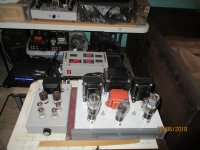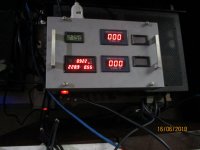ok i got another 0.92 power factor ...
V and I are in-phase. (What that type meter shows.)
Neither may be Sine. In a hot-bottle amp the current will be a lumpy Sine.
Why should we care? The power company is quite able to handle large lumpy loads. An affordable number of 2A3 is not even a large load, utterly insignificant to the power supplier or reasonable house wiring.
Not for the electric bill, that's for sure. But some of us are curious why there is such large discrepancy between Merlin's calculated figure and the Kill-a-Watt's PF reading.Why should we care?
[Edit] Found this article on the "accuracy" of the Kill-a-Watt meter: Teardown, Accuracy Testing: LP7663 Kill-a-Watt-clone Power Usage Meter | Gough's Tech Zone
Cutting to the chase: it's not very accurate at all, and the PF reading is basically 'bogus'. Of course, this should not be taken as a conclusive result, as there are many makes of the wall-plug meter on the market, so YMMV.
...such large discrepancy between Merlin's calculated figure and the Kill-a-Watt....
Is there an excerpt cited near here for "Merlin's calculated figure"?
In context, it 'appears' to be the factor of AC VA to DC Watts.
This is NOT classic Power Factor, as observed on induction motors and reported (perhaps) on a Kill-A-Watt.
We are confounding TWO different "power factors". Apples and oranges.
EDIT: the goughlui.com essay takes yet another meaning for "power factor": the horrendous waveform from a Triac dimmer. And driving an incandescent lamp, even this jagged mess will be near unity Power Factor (in the oldest sense).
Last edited:
V and I are in-phase. (What that type meter shows.)
Neither may be Sine. In a hot-bottle amp the current will be a lumpy Sine.
Why should we care? The power company is quite able to handle large lumpy loads. An affordable number of 2A3 is not even a large load, utterly insignificant to the power supplier or reasonable house wiring.
i don't really care, but since this topic was raised, i got curious...
i am building another 6C33 set, will try to see what gives...
Not for the electric bill, that's for sure. But some of us are curious why there is such large discrepancy between Merlin's calculated figure and the Kill-a-Watt's PF reading.
[Edit] Found this article on the "accuracy" of the Kill-a-Watt meter: Teardown, Accuracy Testing: LP7663 Kill-a-Watt-clone Power Usage Meter | Gough's Tech Zone
Cutting to the chase: it's not very accurate at all, and the PF reading is basically 'bogus'. Of course, this should not be taken as a conclusive result, as there are many makes of the wall-plug meter on the market, so YMMV.
who cares? i have no illusion about its accuracy, but having something to look at is better than wishful thinking...
Off topic - that guy presents great articles - I especially enjoyed a recent one he did on mains AC quality and voltage, frequency and crest-factor variations.[Edit] Found this article on the "accuracy" of the Kill-a-Watt meter: Teardown, Accuracy Testing: LP7663 Kill-a-Watt-clone Power Usage Meter | Gough's Tech Zone
On topic - the accuracy review doesn't broach the non-linear load type that is normally applied by amps, where current waveform has very high crest-factor and almost unity cos phi PF.
Not as such, there's a bit on his website on Rs/Rl wrt the PF, which is taken from his book I believe on PS design (now out of print), but Elerion has SPICE'd it, and said the figure came close to Merlin's figure... anyway, perhaps Merlin or Elerion will chime in with more detailed information.Is there an excerpt cited near here for "Merlin's calculated figure"?
Yes, Merlin is taliking about power factor being Vac-rms / Vdc, as I already said. It is Vac-rms what is heating the wires. And it is this what matters when designing a power transformer and choosing the right wire. He is talking, not about power companies, but about us as transformer users.In context, it 'appears' to be the factor of AC VA to DC Watts.
This is NOT classic Power Factor, as observed on induction motors and reported (perhaps) on a Kill-A-Watt.
We are confounding TWO different "power factors". Apples and oranges.
A power factor of this kind, of 0.92, just contradicts what Merlin is saying. Looking at the charts, it just seems impossible to attain. Also, a simple LTSpice simulation agrees with Merlin charts, as I also said previously. If anyone is interested, I can attach an asc file.
- Status
- This old topic is closed. If you want to reopen this topic, contact a moderator using the "Report Post" button.
- Home
- Amplifiers
- Power Supplies
- Thoughts on power factor and DC windings

